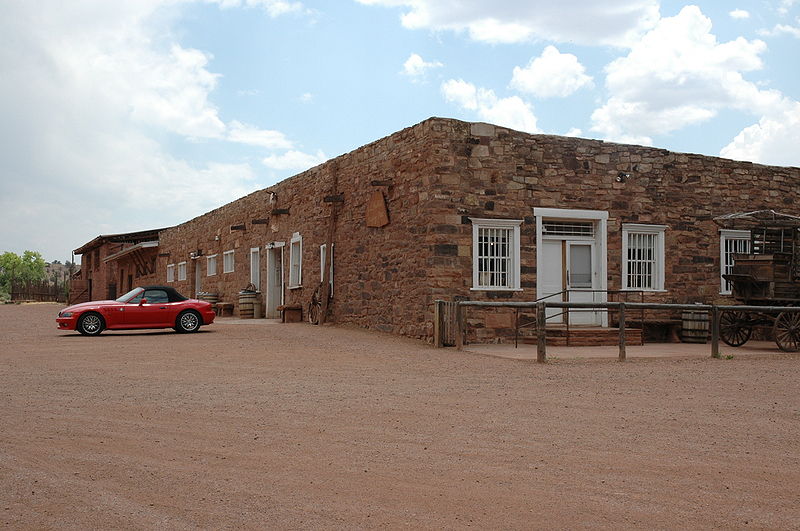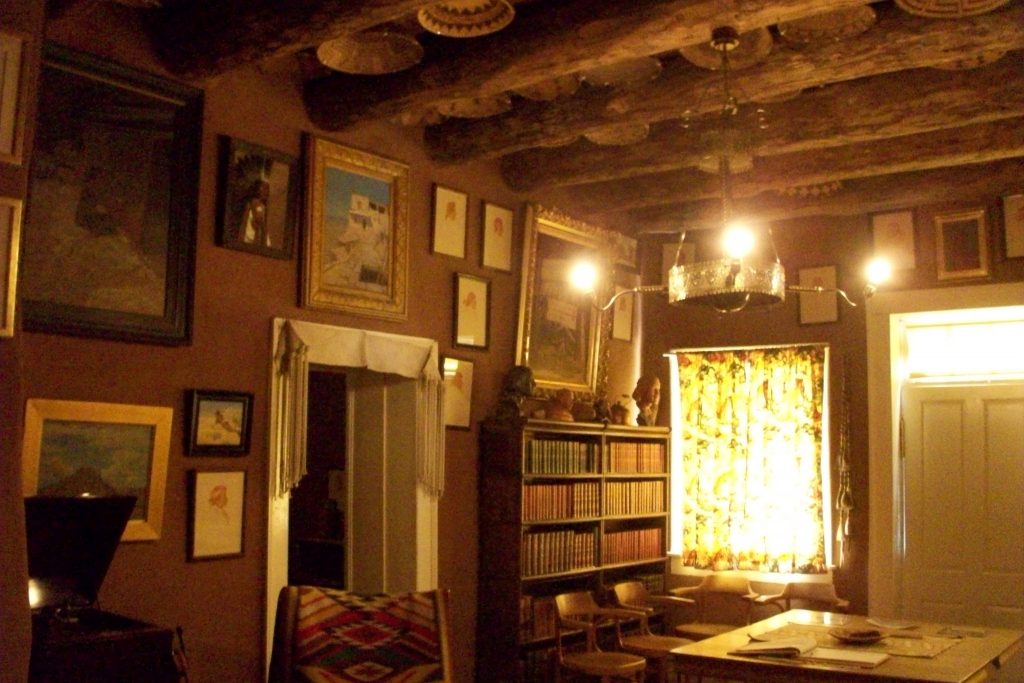Joan and I had a four-day weekend to go further than our customary haunts. A chance to see something different or not as well known to us and enjoy a gift of time.
The place for us? Northern Arizona. Though only a few hours from us, it’s not where we often find ourselves during our travels.
But with the “gift of time,” a five-hour drive for four days of hiking and backpacking seemed a doable idea.
And so we packed our gear, picked the brain of a local friend who knew of the area and made our way to Petrified Forest National Park (PEFO). An area with fossils, archeological sites, badlands and buttes, and a “forest” of petrified wood. Joan spent time there previously; it is new to me, but we both found things off the beaten path.
But we first had a more extended stop at the historical Hubbel Trading Post.
It is one of three National Park Service units managed by the Dine’ (Navajo) people. Still an active trading post, the park unit echoes the area’s history tragically and celebratorily.

From Wikipedia
With strong family roots in the area, Ranger Burbank gave Joan and me a tour of the house restored to its pre-1950 status.
The more we looked at the house, the more we saw that grabbed our interest. Add in the well of knowledge from Ranger Burbank, and it made a planned somewhat quick stop into a trip highlight that made the better part of the later morning and into the early afternoon.

From Wikipedia
After this visit, we went further south to I-40 and Petrified Forest.
Petrified Forest is almost entirely a day-use park to protect natural and historical resources. But you can backpack in a mainly trailless area. As such, we planned to grab a hotel in Holbrook for two nights and then backpack for another night. It was an unusual trip for us, but it allowed us to have a more immersive experience in the park than we could have otherwise.
Our first partial day had us drive along the park to scope it out, enjoy the late afternoon light, and take in natural scenery and some more accessible archeological sites.

As with many national parks, PEFO has a main road that allows people to get out, stretch their legs, and take in some interesting sites.
In this case, some intriguing Pueblo images. The zoom lens on the camera allowed us to see the details of the images we could not see easily.



With daylight soon ending and the park closing, we went to Holbrook, where we would spend the next two nights.
Holbrook is not your typical “gateway community” for a national park. Instead, it is a town that grew up to serve travelers, be it the rail lines, the famous “Route 66”, or the interstate. And, of course, much earlier people.
It’s a town with a more modest vibe than Moab, with an unpretentious feel and more reasonable prices.
In the town, we met up with Jamie. A person I’ve corresponded with for years and someone I met during a southwest road trip in 2018. We enjoyed tasty Mexican food and a round of beer at a nearby watering hole. His insight into the area proved of great use in the days ahead.
The following morning, we made our way to a lesser-known place in the park that had incredible scenery and archeological sites of interest.



The area seemed one of those places we could not entirely see in a day, and every bend of the badlands and hoodoos brought forth fascinating scenery and more intriguing sites that seemed similar, yet slightly different, from our desert home a few hours north.


As we moved along the badlands, we spotted the panel our Moab friend had told us about. It featured motifs we’ve seen throughout the immediate area.

Some images are highly similar to places near our Utah home.

And we saw the eye-catching and perhaps somewhat startling image at the bottom of the panel.

As usual, we found many signs of people traveling this way before, with the remnants of an old wall and some potsherds from different areas and periods.

We continued and enjoyed the scenery that reminded me of the Badlands in South Dakota.

The mixture of browns and reds with the soft stone of the buttes looked more like the High Plains than the desert I know from our home area.

Much like the High Plains, these desert badlands had much beauty because of, and not despite, the stark terrain.
After the morning of hiking, we decided to see more of the popular sites in the park.


Along the path. PCO Joan.
That included a stroll to a reconstructed Pueblo made of petrified wood.

From there, we drove along, visited the sites, and met some local experts.


Toward the end of the park closing, we took in the sights of the famous Painted Desert Inn. A well-known stop on Route 66, the period-era restoration gives a feel for the uniqueness of this building, with local Dine’ artisans doing some of the artwork still found within the building.

PCO Joan.
In the evening, we spent the last night in our hotel room and met up again with Jamie for some more beer, a great talk about trails, and more philosophical outdoor topics, which made our decision to stay in town a good idea.
We went to “The Painted Desert” portion of the park the following morning. This almost trailless area is considered the park’s wildest and most remote area and allows backpacking. And the only way for the public to stay in the park at night.
We had hoped a full day of sunshine would dry out the mud from the recent snow and make for more accessible travel within the area.

We went to a well-known and intricate panel near the Painted Desert section and a popular day hike area.


From there, we crossed the wash that marks the backcountry area’s start, walked another mile, and found a suitable place to camp for the evening.

The warm-ish daytime temps made a bit of a stream in this otherwise dry area.

Joan is rocking the new Woolie from Squak. We’ll do a review at the end of the season. So far, it is an excellent layer.
We followed an obvious travel path and found structures shown on older maps.
From what Joan found via academic papers, the first structure may be part of Dine’ hogan. We don’t know for sure, but it does resemble similar ones in the area.

Based on the same paper, the second structure indicates a base for possible uranium prospecting.

However, outside this paper, other records indicate the building was used as a trading post in the 1920s. The fencing, the debris, and other artifacts painted an interesting story in its own right.

The structure also potentially finds itself along the route used in 1853 and later in 1879 to gather information and petrified wood from the area.

The lay of the land makes for an obvious way to travel through these buttes, washes, and cliffs, and I do not doubt other people used the same route Joan and I found ourselves walking that day.

PCO Joan.
As we returned to our campsite, we noticed the streams melting more and more throughout the day.

With somewhat rare waterfalls in the painted desert drawing us in for a closer view.
We settled into camp, grabbed our warmer clothes, and went to enjoy why we backpacked in the park – The chance to enjoy a desert sunset over the badlands with that amazing winter light.

From Joan.

From above our campsite, the soft glow of the orange lit up the landscape, with every minute giving a different aspect to the landscape.



We watched the last rays of the sun over the butte and again enjoyed another memorable moment that we’ll savor long after we leave the area.

We returned to our tent, enjoyed our typical evening routine, and relished a night in the backcountry.
The following morning, we returned to the vehicle on the rim.

The morning light and the red hues of the cliffs made for a memorable walk out.


We reached our vehicle, grabbed some coffee, and drove home.
Further afield than our typical outings, the “gift of time” affords these opportunities to see new places, and as the months and years go on, we hope to continue to savor our Moab home and places further away.

Petrified Forest is such a great area. It has incredible backcountry. Their “off the beaten path” hikes are all great and get you away from the tourist hordes since most are off trail and require map skills. Devil’s Playground is one of the best collections of hoodoos anywhere. NPS only gives out 3 permits per week to DP.
https://www.nps.gov/pefo/planyourvisit/hiking.htm
We certainly need to return!
This was a beautiful article. One of your best. The story and archeology was a delight. Thanks for posting these.
Thanks for the kind words!
You two should be field consultants for university archeology departments. Maybe give lectures or something. Curious what you did to treat that water on your overnighter. Prefilter? Let it settle first? Looks particularly sediment heavy.
Ha! Joan’s the one who has Dr. in front of her name. 😉
Because of the relatively short hike, we carried in ~10 liters total of water between the two of us. Enough water for the hike in, a day of hiking from camp, and the just under two mile hike out in the morning. No silty runoff!
Thanks for making the trip down to these windswept old badlands!
Our pleasure! We hope you can make it up here, too!